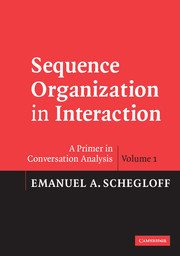Book contents
- Frontmatter
- Contents
- Preface
- Acknowledgments
- 1 Introduction to sequence organization
- 2 The adjacency pair as the unit for sequence construction
- 3 Minimal, two-turn adjacency pair sequences
- 4 Pre-expansion
- 5 The organization of preference/dispreference
- 6 Insert expansion
- 7 Post-expansion
- 8 Topic-proffering sequences: a distinctive adjacency pair sequence structure
- 9 Sequence-closing sequences
- 10 Sequences of sequences
- 11 Retro-sequences
- 12 Some variations in sequence organization
- 13 Sequence as practice
- 14 Summary and Applications
- Appendix 1 Conversation-analytic transcript symbols
- Appendix 2 Transcript of a telephone call
- References
- Index
Preface
Published online by Cambridge University Press: 05 September 2012
- Frontmatter
- Contents
- Preface
- Acknowledgments
- 1 Introduction to sequence organization
- 2 The adjacency pair as the unit for sequence construction
- 3 Minimal, two-turn adjacency pair sequences
- 4 Pre-expansion
- 5 The organization of preference/dispreference
- 6 Insert expansion
- 7 Post-expansion
- 8 Topic-proffering sequences: a distinctive adjacency pair sequence structure
- 9 Sequence-closing sequences
- 10 Sequences of sequences
- 11 Retro-sequences
- 12 Some variations in sequence organization
- 13 Sequence as practice
- 14 Summary and Applications
- Appendix 1 Conversation-analytic transcript symbols
- Appendix 2 Transcript of a telephone call
- References
- Index
Summary
Past and future
A primer, we are told by the Shorter Oxford English Dictionary (Onions, 1980:1,670), is “a small introductory book on any subject.” Some ten years ago, amidst a mixture of encouragement and pestering by colleagues, I set about writing a primer in conversation analysis. I had been teaching a two-term course called “Conversational Structures” to classes of both undergraduate and graduate students for over twenty years by then, and more abbreviated courses to one or the other of these cohorts for several years before that. I had a fairly secure sense of what needed doing and how to get it done. Surely that could be transferred from the lecture hall and discussion room to the pages of a book.
The first term of my course took up three main subjects. First, we discussed what was meant by the term “conversation” in ordinary, informal talk, and what we would mean by it for the purposes of inquiry, and what, furthermore, might be meant by “structures of conversation.” This ordinarily pro forma “introduction to the course” grew over time to three seventy-five-minute lectures, and sometimes part of a fourth. Second, we undertook a rough introduction to turn-taking in conversation – how people get to talk and for how long and with what consequences. For all its roughness, participants found themselves grappling with details of everyday conduct they had never before registered as “things” at all, let alone with the kind of care that was asked of them; let alone the consequentiality they were invited to see in them; let alone doing this for three to four weeks.
- Type
- Chapter
- Information
- Sequence Organization in InteractionA Primer in Conversation Analysis, pp. xi - xvPublisher: Cambridge University PressPrint publication year: 2007

